Google Nexus 5 Review
by Brian Klug on December 5, 2013 8:00 AM EST- Posted in
- Smartphones
- LG
- Android
- Mobile
- Snapdragon 800
- Android 4.4
- Nexus 5
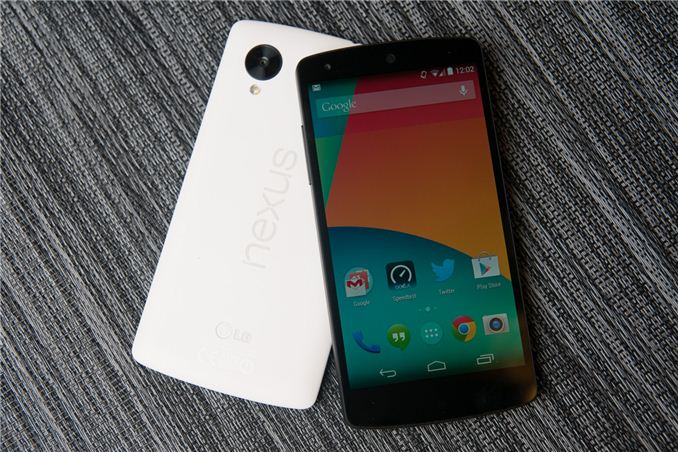
Each year, Google picks a silicon vendor, a hardware partner, and releases a new version of Android running on top of them. The result is a Nexus phone, and for five iterations now that process has repeated, resulting in a smartphone that’s the purest expression of Google’s vision for its mobile platform. Today we’re looking at the Nexus 5.
Nexus 5, as its name makes obvious, is the latest generation of Google’s line of Nexus smartphones, and also is topped by a 5-inch display. While the Nexus program originally started only for smartphones, we’ve seen Google since extend the program to include a 7-inch and 10-inch tablet form factor, as well as a line of accessories. In recent years, we’ve seen Nexus go from being part enthusiast curiosity and development device, to a brand tailored for consumers looking for the latest and greatest the Android platform has to offer at a killer price.
Last generation we saw the Nexus 4, a device that was essentially an LG Optimus G for T-Mobile in different clothing and priced at a competitive price, yet still included the latest and greatest silicon from Qualcomm with APQ8064 (S4 Pro). For Nexus 5, Google has once again gone with hardware partner LG and silicon vendor Qualcomm, this time with a phone that’s somewhat analogous to the LG G2 (but not exactly the same platform) and using the latest and greatest MSM8974 (Snapdragon 800) silicon.
Let’s start with the hardware, since that’s the normal flow for a review. The Nexus 4 bore a lot of superficial similarities to the Optimus G, including a glass back with laser etched design below its surface, the same display, banding, and materials. The Nexus 5 on the other hand doesn’t bear any similarities to the G2, with its buttons on the back, narrow bezel, rounded backside, and glossy plastic. Instead, the Nexus 5’s design borrows much of its industrial design language from the Nexus 7 (2013), with the slightly rounded top and bottom, landscape “nexus” logo on the rear, and large radius curves all around the side. The Nexus 5 and 7 share almost the same shape and profile, and in the case of the black Nexus 5, same rubberized soft touch material on the back and sides. If you scaled down the Nexus 7 design you’d get something which is awfully close to the Nexus 5.
The result is a two-device family that feels like it was made by the same company, and it’s really the first time Google has aligned its industrial design in such a sweeping fashion, in this case even across two different hardware partners. I guess you could make the argument that with the exception of the Nexus 10, Google has eliminated any industrial design fragmentation and finally crafted some hardware design language that it owns for itself.
Google sampled us first a black Nexus 5, and later a white Nexus 5 at my request so I could check out the material differences I saw some discussion about. It’s true that there are some differences between the two devices. For starters, the white device has a backside which eschews the soft touch material, instead giving the polymer-backed device a rougher, textured feeling. The absence of soft touch continues to the edge, which is glossy black plastic instead of the rubberized material, and comes with protective plastic installed over it by default. On the front the only visible difference between white and black is a white colored earpiece, the rest of the bezel around the display is still black.
I’m reminded of the split between the white and black Note 3 with the Nexus 5, which also only includes rubberized material on the black model. I find myself preferring the feeling of the white model instead, but it’s really just a story of personal taste. No doubt the absence of soft touch on the white material is to prevent staining from hand oils or other dyes as the device ages. I don’t find that the absence of soft touch on the white model makes it any more difficult to hold or grip onto, the negative-angled bezel really does help the Nexus 5 fit into the hand securely.
Although the Nexus 5 is a close cousin, it doesn’t adopt the button arrangement from the G2, instead locating the volume and standby buttons in a normal place. Volume rocker ends up on the left, power on the right side.
Likewise earpiece is on top and microUSB is at the bottom of the device. What’s unique about the Nexus 5 buttons is the material of those buttons – they’re ceramic, not polycarbonate. The result is that they’re sharp and instantly locatable with the brush of a finger, it’s a subtle thing that does feel different. The only complaint I have is that they do seem to rattle slightly inside their cutouts. I can affirm that the white model seems to have less rattle, but I’m not entirely sure how much of that is intrinsic to the color difference and absence of soft touch.
Also on the back is the Nexus 5’s oversized camera cutout, which is slightly raised from the surface around it. It’s fair to say that the Nexus 5 does have a camera bump, something that’s not going away soon in all but the most iconic devices. When I first saw the oversized ring, I assumed it was just a design motif, and others later speculated it was for a line of magnetically-attachable add on lenses. To date none of those have materialized, and upon further consideration having magnets next to the VCM (voice coil motor) electromagnetic focus and OIS mechanism could complicate things. In any case, at present the oversized ring around the camera aperture is a unique design point rather than something which serves a function.
The only real negative about the camera cutout is that dust seems to be able to get into the crack surrounding it and the cover glass. It’s something unfortunate about the Nexus 5’s design in general – there are cracks that show dirt quickly, for example the backside has a seam around the edge where dust seems to intrude. It obviously doesn’t change the Nexus 5’s function, but immediately starts looking dirty on the black model, and part of why given both side by side I prefer the white one.
I think pragmatic describes the Nexus 5 design quite well, since honestly the design doesn’t try to be flashy just for the sake of differentiation or make any crazy materials choices on the outside. There are subtle design features which definitely are appreciated, however, like the negative angle to the edge which makes the device easy to grip, those ceramic buttons, and the continuity of design language from the Nexus 7 of course. Materials are a big differentiator between devices right now, and again the Nexus 5 is relatively pragmatic with its choice of polymer, but does deserve kudos for not going with the slick, glossy-surfaced material still preferred by Korean handset makers.
The Nexus 5 feels well made and precision crafted, but I can’t shake the feeling that Nexus 4 felt more like a standout design of its own. The Nexus 5 seems a lot more, well, traditional, without the rounded-glass edges, chrome ring, or pattern below the glass on the back (which I still maintain contained some kind of encoded message). The reality is that Google made a lot of decisions with Nexus to optimize for cost, and that the Nexus 5’s design is actually quite differentiated given the price.
The Nexus 5 adds a lot over its predecessor – larger 1080p display, newer silicon, 802.11ac, better camera with OIS, and of course LTE connectivity, all while getting minimally more expensive than its predecessor. It’s almost unnecessary to say that the Nexus 5 is obviously the best Nexus phone yet.
| Physical Comparison | ||||
| LG G2 | Samsung Galaxy Nexus (GSM/UMTS) | LG Nexus 4 | LG Nexus 5 | |
| Height | 138.5 mm | 135.5 mm | 133.9 mm | 137.84 mm |
| Width | 70.9 mm | 67.94 mm | 68.7 mm | 69.17 mm |
| Depth | 9.14 mm | 8.94 mm | 9.1 mm | 8.59 mm |
| Weight | 143 g | 135 g | 139 g | 130 g |
| CPU |
2.26 GHz MSM8974 (Quad Core Krait 400) |
1.2 GHz OMAP 4460 (Dual Core Cortex A9) | 1.5 GHz APQ8064 (Quad Core Krait) |
2.26 GHz MSM8974 (Quad Core Krait 400) |
| GPU | Adreno 330 | PowerVR SGX 540 @ 304 MHz | Adreno 320 | Adreno 330 |
| RAM | 2 GB LPDDR3 | 1 GB LPDDR2 | 2 GB LPDDR2 | 2 GB LPDDR3 |
| NAND | 16/32 GB NAND | 16/32 GB NAND | 8/16 GB NAND | 16/32 GB NAND |
| Camera | 13 MP with OIS and Flash (Rear Facing) 2.1 MP Full HD (Front Facing) | 5 MP with AF/LED Flash, 1080p30 video recording, 1.3 MP front facing | 8 MP with AF/LED Flash, 1.3 MP front facing | 8 MP with OIS, AF, LED flash, 1.3 MP front facing |
| Screen | 5.2-inch 1920x1080 Full HD IPS LCD | 4.65" 1280x720 SAMOLED HD | 4.7" 1280x768 HD IPS+ LCD | 4.95" 1920x1080 HD IPS LCD |
| Battery | Internal 11.4 Whr | Removable 6.48 Whr | Internal 8.0 Whr | Internal 8.74 Whr |
Google also sent over one of the Nexus 5 bumper cases, which really isn’t so much bumper as it is, well, all around case. The Nexus 4 had bumpers that wrapped around the edge, but left the glass back exposed, much like the iPhone 4/4S era bumpers.
Nexus 5’s bumper case covers up everything but the oversized camera aperture on the back. The red one I got doesn’t seem to be silicone but some other thermoplastic.
At $35 it’s a bit on the pricey side, but it does fit the device nicely and get the job done with some cool neon colors that spice up the Nexus 5.


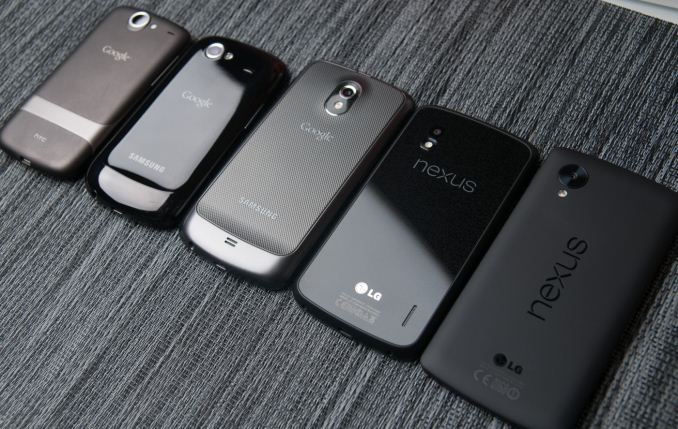
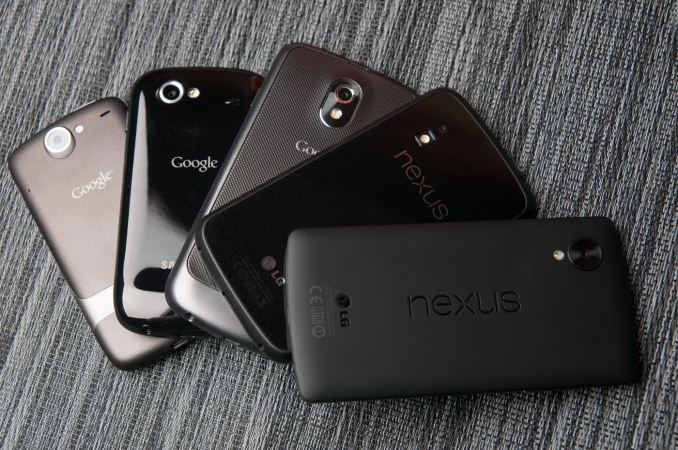
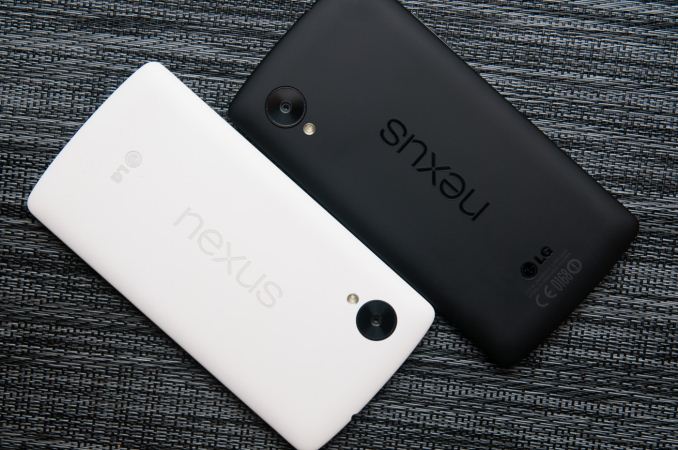
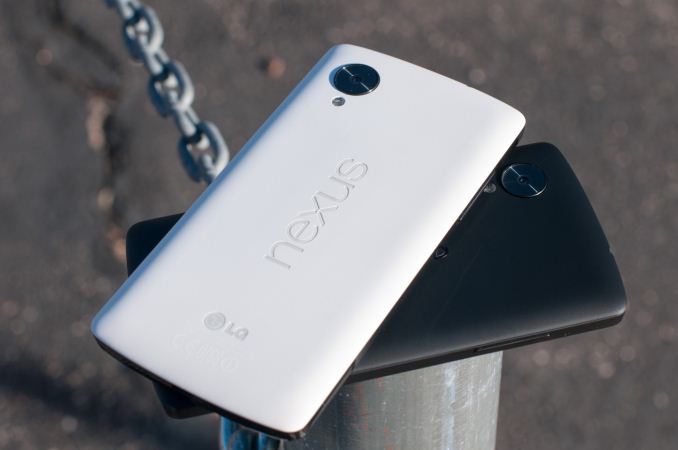
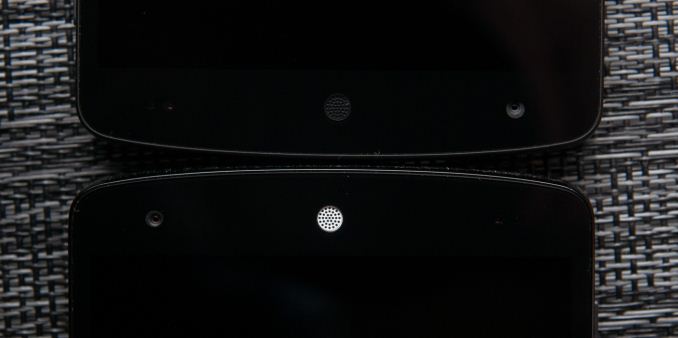
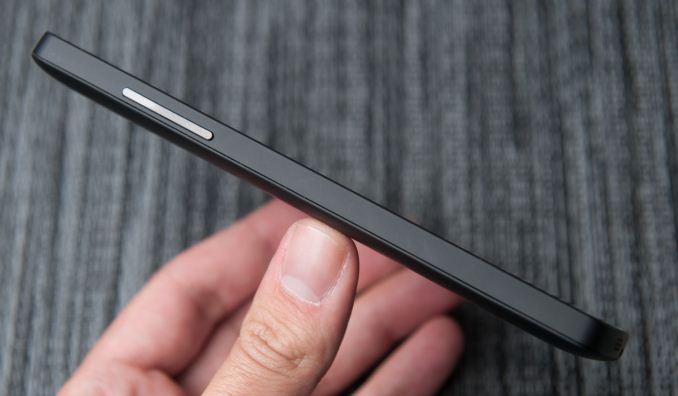
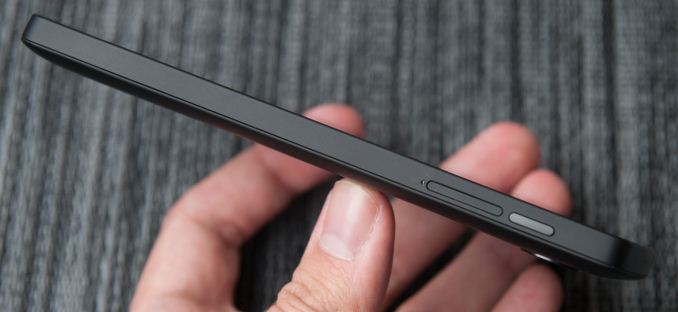








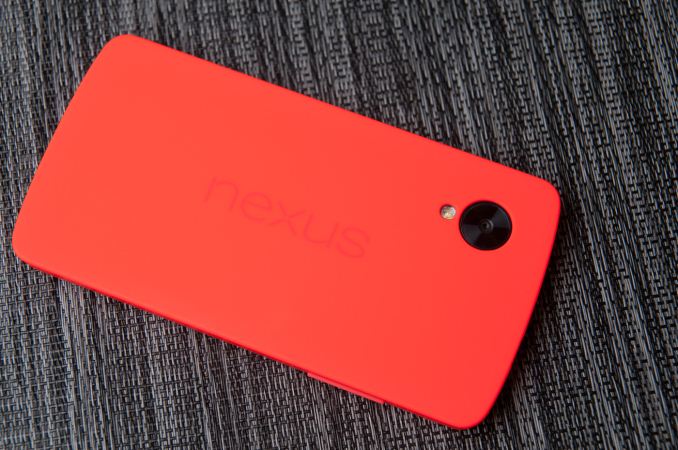
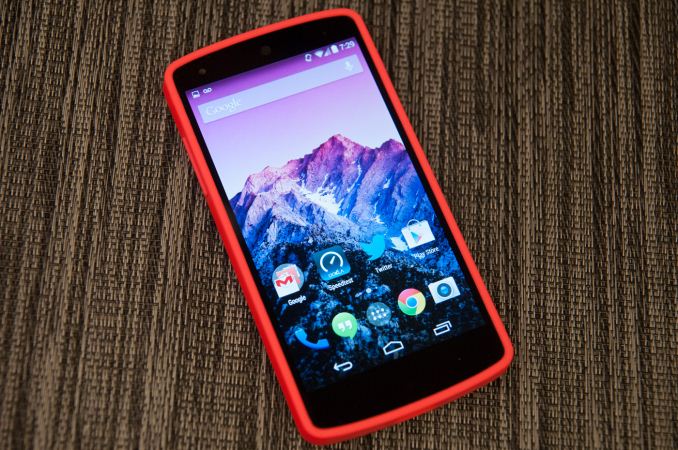








231 Comments
View All Comments
hrrmph - Thursday, December 5, 2013 - link
iPhones are upper-midrange. They don't have:- Tool-less removable back covers (Blackberry, Samsung);
- User replaceable batteries (Blackberry, Samsung);
- Internal user expandable local storage such as via Micro-SDXC slots (Blackberry, Samsung, Sony);
- Dual-SIM slots (Samsung S4, S4-Mini, and Note 3 have variants that are so equipped);
- MS Windows style easy-to-open, easy-to-reduce-to-thumbnail, easy-to-close multitasking windows (BB OS10);
- Interleaving of all communications in one list, such as SMS, Call Data, Email Accounts, Notifications, etc. (Again BB OS10);
- WMA-Lossless audio file support (Android and Blackberry); and
- 4K-60fps OIS-stabilized video recording (okay, nobody has it, but a real flagship device should).
flyingpants1 - Saturday, December 7, 2013 - link
Right. In addition to the screen size thing. And no NFC, or USB, no front speakers, no waterproof, no wireless charging.. there's actually a ton more..erple2 - Saturday, December 7, 2013 - link
To be fair, your first 3 points don't tell me high end at all. Those are just convenience features.The 4th one isn't really all that important outside of a few select markets, so scratch that.
The software itself isn't really a good reason to decide high, medium or low end - there are plenty of Apple Zealots that will tell you the many things Apple does that neither BBX nor Android do, and they'll place some sort of unrealistic weight to that small feature. Curiously, the more I use my phone, the less I care about the fancy interface of the multitasker. Android's method seems to work just fine for me.
The interleaving of communications sounds great, but it comes with one HUGE caveat - crappy app support for EVERYTHING ELSE.
WMA isn't really a deal breaker at all - iOS will play FLAC audio (with an additional app), or the native AppleLossless format.
Though having used an OIS phone in the past, I would consider that a high-end feature..
akdj - Monday, December 9, 2013 - link
What about performance? Camera quality? Eco system, app/development support and software available? Post purchase support? Immediate updates and 'point' updates to kill bugs? Oh, yeah... Performance? Did you happen to notice the 5/5s in the 'upper mid range' scoring in graphics, computational power, battery life (no need to replace batteries), a 64GB option (no need for an SD slot), who cares about dual SIM slot when damn near every "world radio" is built in? Buy a new SIM when you arrive at your destination, with minutes, for ten bucks! iPhones and iPads have long been able to playback lossless formats and FLAC. It's kinda cool, there's typically 'an app for that' when using iOS. Not so much using BB OS10. And Samsung's TouchWiz cream soup is thicker than mashed potatoes (I've got a Note 2). Their phones are more bloated than a new Compaq computer bought at Computer City in 2003 with Vista! I own Android and iOS devices. Daily drive a pair of phones. The Note2 and 5s. I can honestly tell you've got ZERO experience with iPhones...and need to before spewing such silly comments. Who needs 'tool less removable back covers' when your phone runs all day on a charge, doesn't break down, and has options for enough on board storage (that EVERYTHING can be loaded to vs. the VERY select few items I can put on my Note's SD card, essentially limited to media....which is available through iTunes Match via the cloud and doesn't need to be stored) to negate the need, again, to access anything inside!Couple other cool things. Post purchase support...Samsung? Fuggedaboutit! Apple? Take it to the store or call their number....usually they'll just hand you a new one...
...lastly, one thing I've found with my iPhones, I've always sold them and came out ahead after two year of usage! $300 out of pocket on the subsidy, use it two years, sell it for $375...pick up the latest model for $300 then enjoy a nice dinner...or pick up a Mophie case to double my 'juice' if necessary
BBOS 10---the integration of communications is a good idea....in theory. Then again, it's kinda nice to separate email from SMS, Facebook from voicemail....for me at least. As I run a business, some things need to be responded to a bit more professionally than others. I can see myself confusing what I'm responding to. With iOS 7's notification update, this is irrelevant anyway, as it's all just a swipe down front the top of ANY screen within ANY app. Again....use one and you'll educate yourself.
OIS is cool. But it takes up space to be done. And done right....HTC's ONE does get it right, albeit at the expense of shot detail (look at iPhone, Android of your choice vs HTC's pics, their all over as well as excellent reviews of each at dpreview, an excellent camera site, as well as DXOMark). Apple will incorporate it if the technology is there, allows it without sacrifice to shot quality or design aesthetics and usability. Their new burst mode is phenomenal....my 5s shoots faster (with s bigger buffer) than my Canon 7d! All the way up to 100 shots at damn near 10 shots a second....pics what it thinks are the best 'focus' shots so you don't have to dig through....and you can trash the rest.
Again....use one. You might be impressed....unless you enjoy taking your phones apart, then you're absolutely correct. The iPhone isn't for you
gus6464 - Thursday, December 5, 2013 - link
Will you guys be doing a Moto G review? It looks it would be an interesting review for the price it goes for and it's performance.Quicksand Jesus - Thursday, December 5, 2013 - link
Thank goodness there is still a site around that can do a REAL in depth review. I'm so tired of subjective reviews with opinions and no real substance. Other sites could learn alot from Anandtech!naalex - Thursday, December 5, 2013 - link
Thanks for long-awaited and much appreciated review Brian. I was hesitating on buying the Nexus 5 given the shoddy battery-life scaremongering on other websites, but I couldn't wait any longer, so I bought the phone before your review came out. So far, I was thinking I was deluding myself because the battery life has been superb, but your review confirms that the Nexus 5 isn't a dud after all.I also think the camera troubles are a bit overblown for "normal" users. Yes the camera app is wretched, and focusing is a mystery, but the phone can take good-quality pictures in good and low-light conditions. Photography geeks or more discriminating users might be able to tell the difference between the photos taken with the Nexus 5 and its competitors with better camera packages, but I think for most normal users, it's fine. And hella cheap!
grayson_carr - Thursday, December 5, 2013 - link
One thing I'm interested in that you didn't cover Brian. Viewing angles of the display. The viewing angles seem great when looking at the display directly from the sides, top, and bottom, but when looking at it from the corners, it looks seriously washed out (gamma shift?). Just wondering why it does that when HTC's high end LCDs always seem to look good from every angle. If the Nexus 5 is using the same display as the Droid DNA, I would guess it has to do with the Nexus 5 lacking some additional component? A polarization filter perhaps? Know what I'm talking about? Any ideas?Before people go saying "who looks at a device from the corners?", please consider the phone sitting on a table or desk. You usually don't sit it directly in front of you, but off to the side, meaning you're looking at it from a bottom corner if you want to quickly check a notification or something without picking it up. Or maybe you're just showing pictures to people around you. Chances are, they won't be looking at the phone directly from the side, but more from one of the corners. Your pictures might look great to you from directly in front of the phone, while looking washed out and crappy to others around you.
jamdev12 - Thursday, December 5, 2013 - link
Google is updating camera firmware today. Brian are you updating this post with an additional test for the camera? By the way thanks for finally getting this done. I know the holiday season is horrible to get things like this out, but it was well worth the wait.chandgupt - Thursday, December 5, 2013 - link
I believe the ppi is 445 instead of 480. This must affect your "dips" calculation for display size?